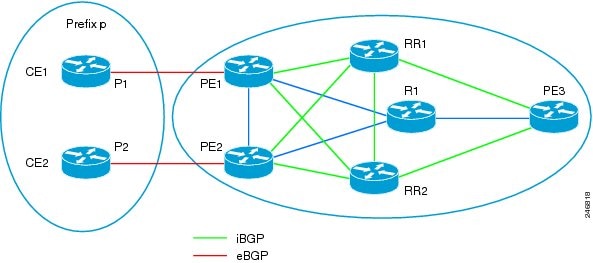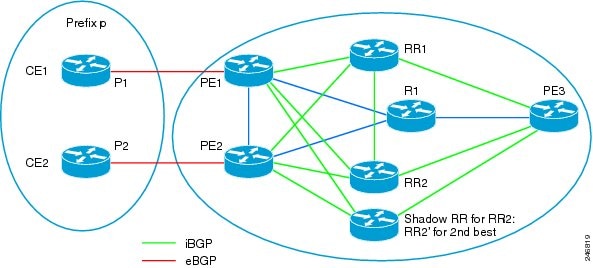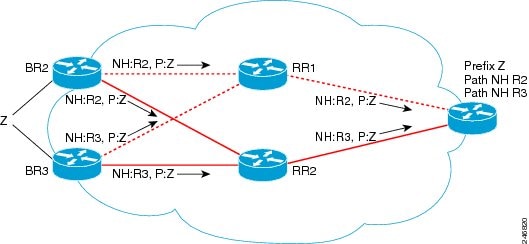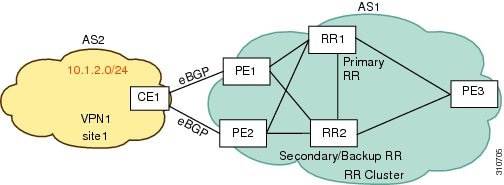- Read Me First
- Cisco BGP Overview
- BGP 4
- Configuring a Basic BGP Network
- BGP 4 Soft Configuration
- BGP Support for 4-byte ASN
- IPv6 Routing: Multiprotocol BGP Extensions for IPv6
- IPv6 Routing: Multiprotocol BGP Link-Local Address Peering
- IPv6 Multicast Address Family Support for Multiprotocol BGP
- Configuring Multiprotocol BGP (MP-BGP) Support for CLNS
- BGP IPv6 Admin Distance
- Connecting to a Service Provider Using External BGP
- BGP Route-Map Continue
- BGP Route-Map Continue Support for Outbound Policy
- Removing Private AS Numbers from the AS Path in BGP
- Configuring BGP Neighbor Session Options
- BGP Neighbor Policy
- BGP Dynamic Neighbors
- BGP Support for Next-Hop Address Tracking
- BGP Restart Neighbor Session After Max-Prefix Limit Reached
- BGP Support for Dual AS Configuration for Network AS Migrations
- Configuring Internal BGP Features
- BGP VPLS Auto Discovery Support on Route Reflector
- BGP FlowSpec Route-reflector Support
- BGP Flow Specification Client
- BGP NSF Awareness
- BGP Graceful Restart per Neighbor
- BGP Support for BFD
- IPv6 NSF and Graceful Restart for MP-BGP IPv6 Address Family
- BGP Link Bandwidth
- Border Gateway Protocol Link-State
- iBGP Multipath Load Sharing
- BGP Multipath Load Sharing for Both eBGP and iBGP in an MPLS-VPN
- Loadsharing IP Packets over More Than Six Parallel Paths
- BGP Policy Accounting
- BGP Policy Accounting Output Interface Accounting
- BGP Cost Community
- BGP Support for IP Prefix Import from Global Table into a VRF Table
- BGP Support for IP Prefix Export from a VRF Table into the Global Table
- BGP per Neighbor SoO Configuration
- Per-VRF Assignment of BGP Router ID
- BGP Next Hop Unchanged
- BGP Support for the L2VPN Address Family
- BGP Event-Based VPN Import
- BGP Best External
- BGP PIC Edge for IP and MPLS-VPN
- Detecting and Mitigating a BGP Slow Peer
- Configuring BGP: RT Constrained Route Distribution
- Configuring a BGP Route Server
- BGP Diverse Path Using a Diverse-Path Route Reflector
- BGP Enhanced Route Refresh
- Configuring BGP Consistency Checker
- BGP—Origin AS Validation
- BGP MIB Support
- BGP 4 MIB Support for Per-Peer Received Routes
- BGP Support for Nonstop Routing (NSR) with Stateful Switchover (SSO) Using L2VPN VPLS
- BGP NSR Auto Sense
- BGP NSR Support for iBGP Peers
- BGP Graceful Shutdown
- BGP — mVPN BGP sAFI 129 - IPv4
- BGP-MVPN SAFI 129 IPv6
- BFD—BGP Multihop Client Support, cBit (IPv4 and IPv6), and Strict Mode
- BGP Attribute Filter and Enhanced Attribute Error Handling
- BGP Additional Paths
- BGP-Multiple Cluster IDs
- BGP-VPN Distinguisher Attribute
- BGP-RT and VPN Distinguisher Attribute Rewrite Wildcard
- VPLS BGP Signaling
- Multicast VPN BGP Dampening
- BGP—IPv6 NSR
- BGP-VRF-Aware Conditional Advertisement
- BGP—Selective Route Download
- BGP—Support for iBGP Local-AS
- eiBGP Multipath for Non-VRF Interfaces (IPv4/IPv6)
- L3VPN iBGP PE-CE
- BGP NSR Support for MPLS VPNv4 and VPNv6 Inter-AS Option B
- BGP-RTC for Legacy PE
- BGP PBB EVPN Route Reflector Support
- BGP Monitoring Protocol
- VRF Aware BGP Translate-Update
- BGP Support for MTR
- BGP Accumulated IGP
- BGP MVPN Source-AS Extended Community Filtering
- BGP AS-Override Split-Horizon
- BGP Support for Multiple Sourced Paths Per Redistributed Route
- Maintenance Function: BGP Routing Protocol
- Finding Feature Information
- Prerequisites for BGP Diverse Path Using a Diverse-Path Route Reflector
- Restrictions for BGP Diverse Path Using a Diverse-Path Route Reflector
- Information About BGP Diverse Path Using a Diverse-Path Reflector
- How to Configure a BGP Diverse-Path Route Reflector
- Configuration Examples for BGP Diverse Path Using a Diverse-Path Route Reflector
- Example: Configuring BGP Diverse Path Where Additional Path Is the Backup Path
- Example: Configuring BGP Diverse Path Where Additional Path Is the Multipath
- Example: Configuring BGP Diverse Path Where Both Multipath and Backup Path Calculations Are Triggered
- Example: Configuring Triggering Computation and Installation of a Backup Path
- Additional References
- Feature Information for BGP Diverse Path Using a Diverse-Path Route Reflector
BGP Diverse Path Using a Diverse-Path Route Reflector
The BGP Diverse Path Using a Diverse-Path Route Reflector feature allows Border Gateway Protocol (BGP) to distribute an alternative path other than the best path between BGP speakers when route reflectors are deployed. This feature is meant to provide path diversity within an autonomous system (AS), within a single cluster only. That is, a route reflector is allowed to advertise the diverse path to its client peers only.
- Finding Feature Information
- Prerequisites for BGP Diverse Path Using a Diverse-Path Route Reflector
- Restrictions for BGP Diverse Path Using a Diverse-Path Route Reflector
- Information About BGP Diverse Path Using a Diverse-Path Reflector
- How to Configure a BGP Diverse-Path Route Reflector
- Configuration Examples for BGP Diverse Path Using a Diverse-Path Route Reflector
- Additional References
- Feature Information for BGP Diverse Path Using a Diverse-Path Route Reflector
Finding Feature Information
Your software release may not support all the features documented in this module. For the latest caveats and feature information, see the Bug Search Tool and the release notes for your platform and software release. To find information about the features documented in this module, and to see a list of the releases in which each feature is supported, see the feature information table at the end of this module.
Use Cisco Feature Navigator to find information about platform support and Cisco software image support. To access Cisco Feature Navigator, go to http://www.cisco.com/go/cfn . An account on Cisco.com is not required.
Prerequisites for BGP Diverse Path Using a Diverse-Path Route Reflector
You should understand the BGP Best External feature.
Restrictions for BGP Diverse Path Using a Diverse-Path Route Reflector
A diverse path can be configured on a route reflector only.
Only one shadow route reflector is allowed per existing route reflector, which will calculate one additional best path (the second best path). That is, only one additional plane (topology) is configured.
Path diversity is configured within an AS, within a single route reflector cluster. That is, the route reflector will advertise the diverse path to its route reflector client peers only.
Diverse path functionality is not supported on a route server.
Information About BGP Diverse Path Using a Diverse-Path Reflector
Limitation that a BGP Diverse Path Overcomes
As a path vector routing protocol, BGP-4 requires a router to advertise to its neighbors only the best path for a destination. However, multiple paths to the same destination would allow mechanisms that can improve resilience, quickly recover from failures, and load balance, for example.
The use of route reflectors is one of the main reasons for poor path diversity within an autonomous system (AS). In a network with route reflectors, even if a prefix is learned from multiple egress routers, the route reflector reflects only the best path to its clients. The figure below shows how deploying route reflectors might reduce path diversity in an AS, even when the BGP Best External feature is deployed.

In the figure above, P1 and P2 are diverse paths for prefix p. Assume Path 2 (P2) has a lower MED and higher local preference than P1. The BGP Best External feature on PE1 will make sure that P1 is propagated to the route reflectors, regardless of P2 having a lower MED and higher local preference. The route reflectors will have path diversity; they will learn both P1 and P2 with different exit points PE1 and PE2 (assuming that PE1 and PE2 have the set ip next-hop self command configured). However, both route reflectors select the best path as P2 due to its lower MED/higher local preference and advertise it to PE3. PE3 will not learn P1 (that is, PE3 will not learn about existing path diversity).
The BGP Diverse Path Using a Diverse-Path Route Reflector feature is a way to resolve that limitation and achieve path diversity.
BGP Diverse Path Using a Diverse-Path Route Reflector
The BGP Diverse Path Using a Diverse-Path Route Reflector feature overcomes the lack of path diversity in an AS containing route reflectors. This feature is meant to provide path diversity within an AS, within a single cluster only. That is, a route reflector is allowed to advertise the diverse path to its client peers only.
For each route reflector in the AS, a shadow route reflector is added to distribute the second best path, also known as the diverse path. The figure below shows the shadow route reflector for RR2. The shadow route reflector improves path diversity because PE3 can now learn both P1 (from RR1/RR2) and learn P2 from the shadow route reflector.
 Note | The primary route reflector and shadow route reflector must have the exact same connections (physical/control plane) to the rest of the routers in the network. |
Shadow route reflectors can be both control plane route reflectors and data plane route reflectors.

The figure below shows a diverse path in greater detail, indicating the next hops:
BR2 announces to RR1 and shadow RR2 that R2 (BR2) is the Next Hop for those who want to reach Prefix Z. Likewise, BR3 announces to RR1 and shadow RR2 that R3 (BR3) is the Next Hop for those who want to reach Prefix Z
RR1 sends a packet to BR1 announcing that the Next Hop is R2 if BR1 wants to reach Prefix Z. The second best path (or diverse path) comes from shadow RR2, which sends a packet to BR1 announcing that the Next Hop is R3 if BR1 want to reach Prefix Z.
At BR1 (far right), we see there are two (diverse) paths to Prefix Z.

Triggers to Compute a BGP Diverse Path
Computation of a diverse path per address family is triggered by any of the following commands:
bgp additional-paths install
bgp additional-paths select
maximum-paths ebgp
maximum-paths ibgp
The bgp additional-paths install command will install the type of path that is specified in the bgp additional-paths select command. If the bgp additional-paths select command specifies both keyword options (best-external and backup), the system will install a backup path.
The maximum-paths ebgp and maximum-paths ibgpcommands trigger a multipath computation, and multipaths are automatically installed as primary paths.
On the other hand, the bgp additional-paths install command triggers computation of a backup path or best-external path.
If the bgp additional-paths select command is not configured, the bgp additional-paths installcommand will trigger both computation and installation of a backup path (as is done with the BGP PIC feature).
IGP Metric Check
Disabling the Interior Gateway Protocol (IGP) metric check and configuring the BGP Diverse Path feature are independent of each other. One does not imply the other. That is, configuring bgp bestpath igp-metric ignore does not imply that the BGP Diverse Path feature is enabled. Conversely, enabling the BGP Diverse Path feature might not require that bgp bestpath igp-metric ignore be configured (because, for example, the route reflector and shadow route reflector are co-located).
The bgp bestpath igp-metric ignore command can be configured at route reflectors and provider edges (PEs).
 Note | Per-VRF functionality for the bgp bestpath igp-metric ignore command is not supported. If you use it anyway, it is at your own risk. |
Route Reflector Determination
If a router’s configuration includes either one of the following commands, the router is a route reflector:
bgp cluster-id
neighbor route-reflector-client
How to Configure a BGP Diverse-Path Route Reflector
Determining Whether You Need to Disable the IGP Metric Check
Before you configure a shadow route reflector in order to get a BGP diverse path, determine whether you need to disable the IGP metric check. The IGP metric is a configurable value indicating physical distance, and is used by an Interior Gateway Protocol, such as Open Shortest Path First (OSPF), Enhanced Interior Gateway Routing Protocol (EIGRP), or Routing Information Protocol (RIP). A smaller IGP metric is preferred over a larger IGP metric.
The locations of the route reflector and shadow route reflector determine whether or not you need to disable the IGP metric check, as follows:
When the route reflector and shadow route reflector are colocated—They have the same IP subnetwork address and are connected to the Ethernet switch with different links. Failure of such a link is equivalent to the route reflector going down. When RRs are colocated, their IGP metrics cannot be different from each other; and therefore there is no need to disable the IGP metric check during the best path calculation at any route reflector. Because there is no need to disable the IGP metric check, the first plane route reflectors do not need to be upgraded to Cisco IOS XE Release 3.4S.
When the shadow route reflector is in a different IGP place from the route reflector (it is not colocated with its best path route reflector)--In this case, the IGP metric check is ignored on both the best path route reflector and shadow route reflector when the best path and second best path are being calculated. The IGP metric check must be disabled on the primary route reflector by configuring the bgp bestpath igp-metric ignore command. This command is available beginning with Cisco IOS XE Release 3.4S, which means you need to upgrade to that release.
Configuring the Route Reflector for BGP Diverse Path
Perform this task to configure a route reflector for the BGP Diverse Path feature. This task specifies the IPv4 address family, but other address families are also supported.
1.
enable
2.
configure
terminal
3.
router
bgp
autonomous-system-number
4.
neighbor
ip-address
remote-as
autonomous-system-number
5.
address-family
ipv4
unicast
6.
neighbor
ip-address
activate
7.
maximum-paths
ibgp
number-of-paths
8.
bgp
bestpath
igp-metric
ignore
9.
bgp
additional-paths
select
[backup]
10.
bgp
additional-paths
install
11.
neighbor
ip-address
route-reflector-client
12.
neighbor
ip-address
advertise
diverse-path
[backup] [mpath]
13.
end
14.
show
ip
bgp
neighbor
ip-address
advertised-routes
DETAILED STEPS
Configuration Examples for BGP Diverse Path Using a Diverse-Path Route Reflector
Example: Configuring BGP Diverse Path Where Additional Path Is the Backup Path
Diverse path functionality is contained within a single cluster; that is, only the clients of a route reflector can be configured to advertise the diverse path. A diverse path is advertised to the clients of a route reflector only if the client is configured to get the additional path.
A shadow route reflector can be added to calculate and advertise the additional path, or an existing route reflector can be configured to calculate and advertise the additional path. In the figure below, instead of adding a shadow route reflector, RR2 (the existing backup RR) is configured to calculate the additional path and advertise it to a particular neighbor.
In the figure below, assume that from the route reflectors, the path to CE1 via PE1 is preferred over the path via PE2. Without the diverse path feature, both route reflectors will advertise to PE3 that the path to CE1 is via PE1. If the connection between RR1 and PE1 fails (or the path between PE1 and CE1 fails), there is no other path.

In the following configuration example based on the figure above, RR2 is configured with an additional path, which is a backup path.
If RR1 and RR2 are not colocated, you must configure the bgp bestpath igp-metric ignore command before the additional path is calculated. (If RR1 and RR2 are colocated, do not configure that command.)
The bgp additional-paths select backup command triggers calculation of the backup path at RR2, which is the path via PE2.
The bgp additional-paths install command installs the backup path if RR2 is in the forwarding plane. (Do not configure this command if RR2 is in the control plane.)
The address of PE3 is 10.1.1.1, and that address is used in the neighbor advertise diverse-path backup command on RR2. This command triggers advertisement of the backup path to PE3. PE3 will learn the best path, (which is the path via PE1) from RR1, and it will learn the backup path from RR2.
RR2
router bgp 1 neighbor 10.1.1.1 remote-as 1 address-family ipv4 unicast neighbor 10.1.1.1 activate maximum-paths ibgp 4 bgp bestpath igp-metric ignore bgp additional-paths select backup bgp additional-paths install neighbor 10.1.1.1 route-reflector-client neighbor 10.1.1.1 advertise diverse-path backup
Example: Configuring BGP Diverse Path Where Additional Path Is the Multipath
In the following example based on the figure above, assume that paths toward CE1 via PE1 and PE2 are multipaths. The maximum-paths ibgp command will trigger calculation of multipaths.
The address of PE3 is 10.1.1.1, and that address is used in the neighbor advertise diverse-path mpath command on RR2. This command will trigger advertisement of the multipath, that is, the second best path, to PE3. PE3 will learn the best path, path via PE1 from RR1, and will learn second best path from RR2.
RR2
router bgp 1 neighbor 10.1.1.1 remote-as 1 address-family ipv4 unicast neighbor 10.1.1.1 activate maximum-paths ibgp 4 neighbor 10.1.1.1 remote-as 1 neighbor 10.1.1.1 route-reflector-client neighbor 10.1.1.1 advertise diverse-path mpath
Example: Configuring BGP Diverse Path Where Both Multipath and Backup Path Calculations Are Triggered
The following example is based on the figure above. The maximum-paths ibgp command will trigger calculation of multipaths. When both multipath and backup path calculations are triggered, the backup path and the second multipath (which is the second best path) are the same paths and it will be installed as the active path, regardless of whether the route reflector is in the control plane or forwarding plane.
The address of PE3 is 10.1.1.1, and that address is used in the neighbor advertise diverse-path backup mpath command on RR2. This command causes RR2 to advertise the second best path, which is the second multipath, to PE3.
RR2
router bgp 1 neighbor 10.1.1.1 remote-as 1 address-family ipv4 unicast neighbor 10.1.1.1 activate maximum-paths ibgp 4 bgp additional-paths select backup neighbor 10.1.1.1 remote-as 1 neighbor 10.1.1.1 route-reflector-client neighbor 10.1.1.1 advertise diverse-path backup mpath
Example: Configuring Triggering Computation and Installation of a Backup Path
When the bgp additional-paths install command is configured without configuring bgp additional-paths select backup, the former command will trigger both computation and installation of the backup path (as it is with the existing BGP PIC feature).
The address of PE3 is 10.1.1.1, and that address is used in the neighbor advertise diverse-path backup command on RR2. This command will trigger advertisement of a backup path to PE3. PE3 will learn the best path, a path via PE1 from RR1, and it will learn a backup path from RR2.
RR2
router bgp 1 neighbor 10.1.1.1 remote-as 1 address-family ipv4 unicast neighbor 10.1.1.1 activate maximum-paths ibgp 4 bgp additional-paths install neighbor 10.1.1.1 remote-as 1 neighbor 10.1.1.1 route-reflector-client neighbor 10.1.1.1 advertise diverse-path backup
Additional References
Related Documents
|
Related Topic |
Document Title |
|---|---|
|
Cisco IOS commands |
|
|
BGP commands |
|
|
Configuring BGP Best External Path on a Route Reflector for Intercluster |
BGP Best External module |
|
BGP configuration tasks |
Standards
|
Standard |
Title |
|---|---|
|
draft-ietf-grow-diverse-bgp-path-dist-02.txt |
Distribution of Diverse BGP Paths |
MIBs
|
MIB |
MIBs Link |
|---|---|
|
No new or modified MIBs are supported by this feature, and support for existing MIBs has not been modified by this feature. |
To locate and download MIBs for selected platforms, Cisco software releases, and feature sets, use Cisco MIB Locator found at the following URL: |
RFCs
|
RFC |
Title |
|---|---|
|
RFC 4271 |
Technical Assistance
|
Description |
Link |
|---|---|
|
The Cisco Support and Documentation website provides online resources to download documentation, software, and tools. Use these resources to install and configure the software and to troubleshoot and resolve technical issues with Cisco products and technologies. Access to most tools on the Cisco Support and Documentation website requires a Cisco.com user ID and password. |
Feature Information for BGP Diverse Path Using a Diverse-Path Route Reflector
The following table provides release information about the feature or features described in this module. This table lists only the software release that introduced support for a given feature in a given software release train. Unless noted otherwise, subsequent releases of that software release train also support that feature.
Use Cisco Feature Navigator to find information about platform support and Cisco software image support. To access Cisco Feature Navigator, go to www.cisco.com/go/cfn. An account on Cisco.com is not required. Feedback
Feedback